
Review
Arc Raiders: an extraction shooter for the masses
by Philipp Rüegg

Whether it’s base building, terraforming or sheer survival, there’s plenty to do in The Planet Crafter. The game rewards my efforts with a changing environment.
I’m sitting in a tiny capsule, rocketing towards a red planet – my new home. What awaits me there is a depressing, rocky landscape with zero signs of life. I’m scarcely out of the capsule when I’m confronted with the threat of death by suffocation. But I don’t let that put me off. After all, I’ve got my sights set on a goal: to create a green paradise on the planet.
The Planet Crafter is a survival game created by French indie developer duo Miju Games. Since you need to collect resources and build a base from a first-person perspective, it reminds me of games like Subnautica and Astroneer at first. The story’s rudimentary, but it’s not essential for the game to work. What’s really important is the overarching goal: terraforming. In The Planet Crafter, your actions have a lasting impact on the environment.
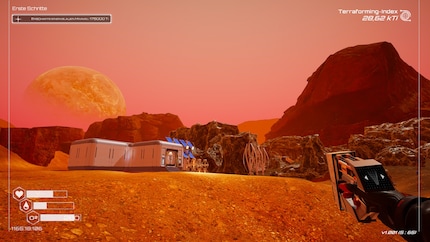
I start my ambitious terraforming project with the most important thing: staying alive. Your character can die from a lack of oxygen, hunger or thirst. With this in mind, I grab my multifunctional tool and use it to collect resources such as iron, silicon and titanium, which are lying all over the ground. This can be used to build modular accommodation from containers. Inside these containers, there’s unlimited oxygen and space for storage boxes and equipment.
Another thing you can use this space for is a craft station, which enables you to build better equipment, including a larger oxygen tank. This, in turn, helps you expand your radius for gathering resources. To get drinking water, I melt ice. Though a few packs of astronaut food in my inventory initially satisfy my hunger, I move on to growing zucchinis and beans later.
My sense of ambition quickly begins to stir – I want better equipment and I want my base to look good. It could definitely use some windows and furniture. And it’s got to be organised too. The resources I’ve gathered need to be stowed away somewhere handy, where they’re easy to find again. Luckily, you can label the boxes. However, as the game reminds me with its gentle hints on objectives in the corner of the screen, there’s more to life here than DIY.
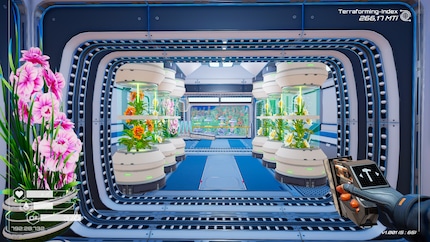
Now for the real work. You see, terraforming a planet is quite the task. You’ve got to gradually adjust the conditions on the planet’s surface in order to sustain life. The parameters you use are oxygen, temperature and air pressure, with biomass featuring later on. While this may sound complicated, it’s boiled down to the bare essentials in the game. I grow oxygen-producing plants in special chambers, radiators give off heat, and large drills working on the planet’s surface release gases that increase atmospheric pressure.
At first, I don’t see much of an impact of this. It isn’t until later that the environment around me changes. The surrounding ice melts and lakes form. I very painfully learned that certain choices of base location are unwise when mine was flooded. As time goes on, there are fewer sandstorms, the sky turns blue and the ground is carpeted with green moss. That said, this newly green ground doesn’t look great. Though it changes colour, it doesn’t change texture. Thankfully, this unsightliness can be concealed with tactically placed, brightly coloured flowers.
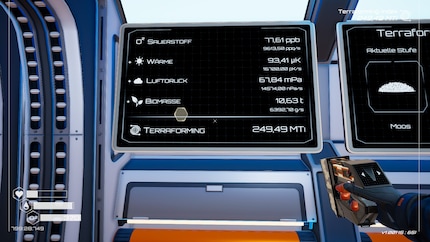
Creating a world here on my private planet, I feel like a god. I put up a screen in my base to display my steadily increasing terraforming parameters and the milestones I’ll achieve next.
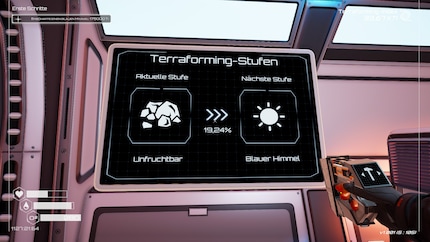
For all these wonderful terraforming machines to work, they need electricity. A small solar panel is all it takes to power my base initially, but I soon wind up needing a whole forest of them. In the medium term, I need a nuclear fusion reactor.
As long as the base has power, you can make steady progress. The terraforming machines do what they’re supposed to do – even without my intervention – and I keep on reaching terraforming milestones. Hitting these goals gives me access to new and improved machines and base modules that speed up the process. But they also require more power. As a result, I’m forced to go off in search of rare resources.
Exploration is an important aspect of The Planet Crafter. On my forays across the non-procedurally generated map, I explore caves, abandoned bases and crashed spaceships. I soon start cursing my seemingly constantly overfilled inventory. Finding little outposts with storage boxes is essential for my progress.
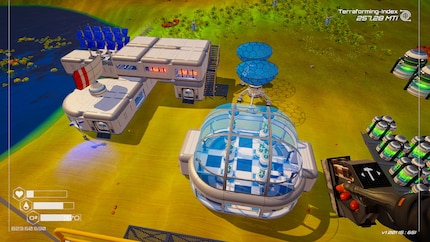
The pitch-black wrecks I come across on my expeditions put the fear of God into me. Not only do I have a rational fear of getting lost and suffocating (hello, claustrophobia!), but against my better judgement, I’m scared there’s something nasty lurking around every corner. However, enduring the heebie-jeebies turns out to be worth it. Wrecks, ruins and caves are full of valuable resources, collectables and microchips I can later use as blueprints for new equipment. Too bad for the crew who crashed or starved to death, but good news for me. Incidentally, those unfortunate souls are nowhere to be found, and I’m spared the sight of shrivelled-up corpses.
As plants, corals and trees start sprouting up, I begin conducting genetic experiments and breeding my first animals. In addition to insects and amphibians, there are also bigger, brightly coloured land animals to create.
Graphically, The Planet Crafter can’t compete with initially similar games such as Subnautica or Satisfactory. But that doesn’t matter. Seeing the sky turning bluer and bluer and lakes forming makes up for it.
Collecting resources is an important part of the game, but it doesn’t turn into a tedious grind. Basic resources are always close by. Hunting for rare resources involves exploring new areas, so it never gets boring either. Nevertheless, I can still adjust the level of difficulty, frequency of resources and terraforming duration in the settings to suit my preferences.
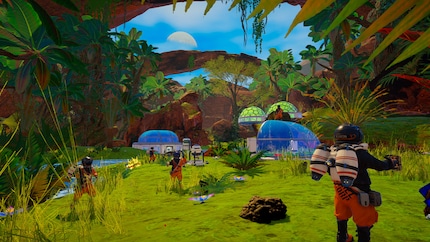
Having previously enjoyed terraforming in Green Planet, the Surviving Mars DLC, it’s the same story with The Planet Crafter. It’s a leisurely game with no battles and genuine rewards – my efforts transform a dead game world into a living oasis.
After two years in Early Access, The Planet Crafter was released in full on Steam on 10 April. A co-op mode for up to ten players was added with the release of the full version. Version 1.0 also includes three new biomes to explore, new story elements and additional endgame content. There’s a discount of 30 per cent available until 24 April.*
Feels just as comfortable in front of a gaming PC as she does in a hammock in the garden. Likes the Roman Empire, container ships and science fiction books. Focuses mostly on unearthing news stories about IT and smart products.
Which films, shows, books, games or board games are genuinely great? Recommendations from our personal experience.
Show all